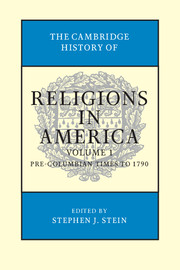Book contents
- Frontmatter
- Contents
- Contributors
- Editor's Introduction
- SECTION I BACKGROUND ON RELIGIOUS TRADITIONS – PRE-1500S
- SECTION II RELIGIONS IN THE POST-COLUMBIAN NEW WORLD – 1500–1680S
- SECTION III RELIGIOUS PATTERNS IN COLONIAL AMERICA – 1680S–1730S
- SECTION IV RELIGIOUS DIVERSITY IN BRITISH AMERICA – 1730S–1790
- SECTION V AMERICAN RELIGIONS IN THE EIGHTEENTH-CENTURY INTERNATIONAL CONTEXT
- SECTION VI THEMATIC ESSAYS
- 32 Religious Thought: The Pre-Columbian Era to 1790
- 33 Piety and Practice in North America to 1800
- 34 Sacred Music in Colonial America
- 35 Religious Architecture
- 36 Religion and Visuality in America: Material Economies of the Sacred
- 37 Religion and Race
- 38 Religions and Families in America: Historical Traditions and Present Positions
- 39 Religious History
- Index
- References
35 - Religious Architecture
from SECTION VI - THEMATIC ESSAYS
Published online by Cambridge University Press: 28 July 2012
- Frontmatter
- Contents
- Contributors
- Editor's Introduction
- SECTION I BACKGROUND ON RELIGIOUS TRADITIONS – PRE-1500S
- SECTION II RELIGIONS IN THE POST-COLUMBIAN NEW WORLD – 1500–1680S
- SECTION III RELIGIOUS PATTERNS IN COLONIAL AMERICA – 1680S–1730S
- SECTION IV RELIGIOUS DIVERSITY IN BRITISH AMERICA – 1730S–1790
- SECTION V AMERICAN RELIGIONS IN THE EIGHTEENTH-CENTURY INTERNATIONAL CONTEXT
- SECTION VI THEMATIC ESSAYS
- 32 Religious Thought: The Pre-Columbian Era to 1790
- 33 Piety and Practice in North America to 1800
- 34 Sacred Music in Colonial America
- 35 Religious Architecture
- 36 Religion and Visuality in America: Material Economies of the Sacred
- 37 Religion and Race
- 38 Religions and Families in America: Historical Traditions and Present Positions
- 39 Religious History
- Index
- References
Summary
The peoples whom European explorers, conquerors, and colonists found in North America were as diverse as the newcomers would eventually become, and their built environment, including their sacred structures, was equally diverse. One of the determining factors was their natural environment and the lifestyle it dictated. Northern peoples, who depended on hunting for much of their sustenance, followed a semi-nomadic course, and the buildings they constructed were often impermanent. Those further south, where the land conduced to agriculture, were able to erect more elaborate and permanent structures, such as the sun temple in the “grand village” of the mound-building Natchez near today's Mississippi city of that name. Still further south, in what is now Mexico, imperial powers such as the Aztecs arose, which were able to command the resources to build vast temple complexes such as that at Tenochtitlán near present-day Mexico City.
For most of the aboriginal peoples of present-day Canada and the United States, sacrality was not confined to buildings set apart for ritual use, although the latter certainly existed. The lines that separate public and private as well as sacred and secular were blurry or absent among native peoples. The longhouse of the Iroquois in upstate New York, for example, served as a general center both for family residence and for communal activity, whether in the form of ritual or public discussions. Like many native structures, it was modeled on a legendary prototype.
- Type
- Chapter
- Information
- The Cambridge History of Religions in America , pp. 728 - 747Publisher: Cambridge University PressPrint publication year: 2000

